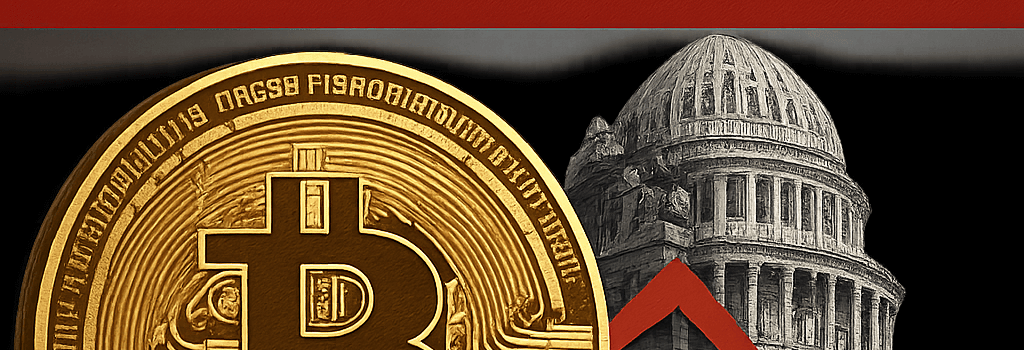GOP Crypto Bills May Spark Financial Crisis

Updated: August 2025 – With Congress racing to pass the GENIUS and CLARITY Acts, experts warn that these pro-industry measures risk undermining financial stability, exposing millions of Americans to scams, and creating systemic vulnerabilities.
The Push for Stablecoins in “Crypto Week”
This summer, lawmakers dubbed it “Crypto Week”: three high-stakes days in July 2025 when the Senate passed the GENIUS Act (Guaranteeing Equitable National Infrastructure for US Stablecoins), and the House prepared a vote on the CLARITY Act. Together, they aim to establish a federal framework for stablecoins and digital assets, but critics say the bills fall far short on consumer protections and risk management.
What the GENIUS Act Does—and Doesn’t Do
- Permissive Collateral: Allows issuers to back stablecoins with “high-quality liquid assets”—a term critics say is too vague and may include corporate debt, low-grade repo agreements, or algorithmic reserves.
- No Mandatory Dollar Peg: Unlike existing regulatory drafts, the GENIUS Act doesn’t require a 1:1 US dollar peg, enabling “synthetic” or hybrid models that rely on dynamic smart-contract algorithms.
- Limited Oversight: The bill grants minimal authority to the Financial Stability Oversight Council (FSOC) and omits robust audit requirements or on-chain proof-of-reserves standards.
- Consumer Protections: Lacks deposit insurance (e.g., FDIC-like coverage), dispute-resolution mandates, and liability limits for unauthorized transactions—features standard in traditional banking.
Key Technical Risks and Vulnerabilities
- Peg Instability: Algorithmic stablecoins (e.g., rebase tokens) have historically collapsed when arbitrage mechanisms fail under stress. Without a guaranteed dollar peg, volatility can cascade through DeFi protocols.
- Network Congestion: Mass adoption on Ethereum or Layer-2 chains can trigger gas price spikes, raising transaction costs above consumer thresholds (typically $0.10–$0.20 per transfer).
- Smart-Contract Exploits: Over 15 major DeFi hacks in 2024 exploited reentrancy and flash loan vulnerabilities, draining over $500 million. The GENIUS Act doesn’t mandate code audits or formal verification (e.g., using tools like CertiK or Slither).
- Cross-Chain Bridging: Bridging assets between chains involves liquidity pools and multi-signature (multi-sig) custodial setups. Weak governance models could allow single points of failure or exit scams.
New Section: Technical Architecture of a regulated Stablecoin Framework
Under the proposed legislation, stablecoin issuers would integrate with Fedwire and CHIPS via ISO 20022 messaging standards. Issuers must maintain real-time proof-of-reserves using zero-knowledge proofs (ZKPs) to validate collateral backing without disclosing proprietary data. But draft rules stop short of enforcing on-chain ZKP implementations or third-party attestations, leaving cryptographic audit trails optional.
New Section: Impact on Banking Infrastructure and Interoperability
Should major tech firms like Amazon or Meta become stablecoin issuers, payment rails could shift from SWIFT/ACH to blockchain-based rails. While this offers faster settlement (T+0 versus T+2), it pressures traditional banks to retrofit core banking systems for tokenized asset custody. Firms may adopt ISO 8583 bridges or SWIFT’s Global Payment Innovation for hybrid on-chain/on-bank transfers, but integration costs run into the billions.
New Section: Risk Analysis and Mitigation Strategies
“Without strict reserve requirements and enforceable customer redemption rights, any systemic shock could trigger a run on stablecoins akin to a bank run,” warns Ebrahim Poonawala, BofA’s head of North American banks research.
Proposed mitigations include:
- Mandatory Proof-of-Reserves: Quarterly attestations via Merkle-tree ZKPs to independent auditors.
- Insolvency Priority: Explicit statutory language elevating customer claims over general creditors in case of issuer insolvency.
- Regulatory Sandbox: A phased approach where new issuers must operate under limited volumes (< $100 M market cap) and capital buffers until full compliance.
Political Battle and Industry Response
Rep. Maxine Waters (D-CA) calls the bills “written by and for the crypto oligarchy,” warning they lack funding for regulators like the SEC and the CFPB. White House crypto advisor Bo Hines signaled on X (formerly Twitter) that President Trump—who faces scrutiny over alleged crypto conflicts—plans to sign both bills swiftly.
Senate Champion’s Defense
Sen. Tim Scott asserts “simple monthly disclosure” and annual attestations suffice for consumer safety. He also claims customers will be prioritized in insolvency, but critics say those provisions aren’t binding without explicit statutory language.
Expert Opinions and Latest Developments
In August 2025, the Office of the Comptroller of the Currency (OCC) issued a non-binding interpretive letter clarifying that federally chartered banks may custody stablecoins but must segregate reserve assets. Meanwhile, the Federal Reserve continues trials on a Central Bank Digital Currency (CBDC) prototype with Swift and ConsenSys, highlighting public sector alternatives to private stablecoins.
Consumer Guidance and Industry Implications
Delicia Hand, Senior Director of Digital Marketplaces at Consumer Reports, advises: “Treat stablecoins like prepaid cards—use only for small transactions until regulatory frameworks mature.” She recommends vetting dispute-resolution processes and customer support channels before adoption.
Conclusion
If enacted without robust amendments, the GENIUS and CLARITY Acts may usher in a new era of unregulated digital payments, consolidating power in Big Tech, weakening traditional banks, and leaving consumers vulnerable to fraud and systemic shocks. As Congress reconvenes this fall, further revisions will be critical to align innovation with safety.